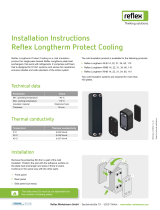
3
1 Introduction ............................................................................................................................................ 4
1.1 Instructions ...............................................................................................................................................4
1.2 Intended Use ............................................................................................................................................4
1.3 Safety Instructions ....................................................................................................................................5
1.4 Environment .............................................................................................................................................5
2 Installation .............................................................................................................................................. 6
2.1 Device Overview ...................................................................................................................................... 6
2.2 Unpacking and Setting-up the Printer ...................................................................................................... 8
2.3 Installing the Wi-FI stick ........................................................................................................................... 8
2.4 Connecting the Device .............................................................................................................................9
2.4.1 Connecting to the Power Supply ........................................................................................................ 9
2.4.2 Connecting to a Computer or Computer Network .............................................................................. 9
2.5 Switching on the Device ...........................................................................................................................9
3 Touchscreen Display ........................................................................................................................... 10
3.1 Start Screen ........................................................................................................................................... 10
3.2 Navigation in the Menu ..........................................................................................................................12
4 Loading Material ...................................................................................................................................13
4.1 Loading Media from Roll ........................................................................................................................ 13
4.1.1 Positioning the Media Roll on the Roll Retainer ...............................................................................13
4.1.2 Inserting the Media into the Printhead ..............................................................................................14
4.1.3 Setting the Label Sensor .................................................................................................................. 14
4.1.4 Winding up the Media Strip in Rewind Mode....................................................................................15
4.1.5 Removing the Wound Roll ................................................................................................................16
4.1.6 Winding up the Liner in Peel-Off mode .............................................................................................17
4.2 Loading Fanfold Media ...........................................................................................................................18
4.3 Setting the Head Locking System ..........................................................................................................19
4.4 Removing and Installing the Rewind Guide Plate, Dispense Plate or Tear-off Plate .............................20
4.5 Loading Transfer Ribbon ........................................................................................................................21
4.6 Setting the Feed Path of the Transfer Ribbon ........................................................................................22
5 Printing Operation ................................................................................................................................23
5.1 Synchronization of the Paper Feed ........................................................................................................23
5.2 Tear-off Mode .........................................................................................................................................23
5.3 Peel-off Mode .........................................................................................................................................23
5.4 Internal Rewinding .................................................................................................................................23
5.5 Suppressing Backfeed (SQUIX MT only) ...............................................................................................24
5.6 Avoiding Loss of Material (SQUIX MT only) ...........................................................................................24
6 Cleaning ................................................................................................................................................25
6.1 Cleaning Information ..............................................................................................................................25
6.2 Cleaning the Print Roller ........................................................................................................................ 25
6.3 Cleaning the Printhead ...........................................................................................................................25
6.4 Cleaning the Label Sensor .....................................................................................................................26
7 Fault Correction ...................................................................................................................................27
7.1 Error Display ..........................................................................................................................................27
7.2 Error Messages and Fault Correction .................................................................................................... 27
7.3 Problem Solution ....................................................................................................................................29
8 Media .....................................................................................................................................................30
8.1 Media Dimensions ..................................................................................................................................30
8.2 Device Dimensions ...............................................................................................................................31
8.3 ReexMarkDimensions ........................................................................................................................ 32
8.4 Cut-out Mark Dimensions .......................................................................................................................33
9 Licenses ................................................................................................................................................34
9.1 Reference to the EU Declaration of Conformity .....................................................................................34
9.2 FCC ........................................................................................................................................................34
10 Index ......................................................................................................................................................35
Table of Contents





















